Fabrizio De Vico Fallani
HappyFeat -- An interactive and efficient BCI framework for clinical applications
Oct 04, 2023Abstract:Brain-Computer Interface (BCI) systems allow users to perform actions by translating their brain activity into commands. Such systems usually need a training phase, consisting in training a classification algorithm to discriminate between mental states using specific features from the recorded signals. This phase of feature selection and training is crucial for BCI performance and presents specific constraints to be met in a clinical context, such as post-stroke rehabilitation. In this paper, we present HappyFeat, a software making Motor Imagery (MI) based BCI experiments easier, by gathering all necessary manipulations and analysis in a single convenient GUI and via automation of experiment or analysis parameters. The resulting workflow allows for effortlessly selecting the best features, helping to achieve good BCI performance in time-constrained environments. Alternative features based on Functional Connectivity can be used and compared or combined with Power Spectral Density, allowing a network-oriented approach. We then give details of HappyFeat's main mechanisms, and a review of its performances in typical use cases. We also show that it can be used as an efficient tool for comparing different metrics extracted from the signals, to train the classification algorithm. To this end, we show a comparison between the commonly-used Power Spectral Density and network metrics based on Functional Connectivity. HappyFeat is available as an open-source project which can be freely downloaded on GitHub.
Functional connectivity ensemble method to enhance BCI performance (FUCONE)
Nov 04, 2021

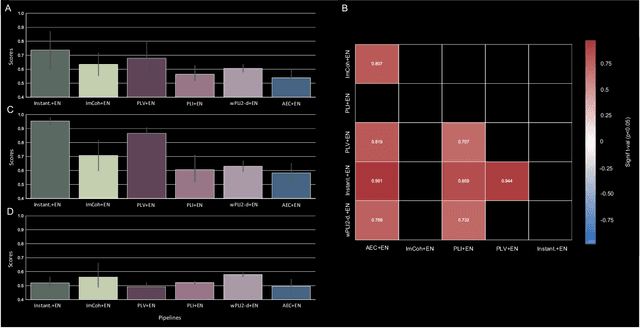

Abstract:Functional connectivity is a key approach to investigate oscillatory activities of the brain that provides important insights on the underlying dynamic of neuronal interactions and that is mostly applied for brain activity analysis. Building on the advances in information geometry for brain-computer interface, we propose a novel framework that combines functional connectivity estimators and covariance-based pipelines to classify mental states, such as motor imagery. A Riemannian classifier is trained for each estimator and an ensemble classifier combines the decisions in each feature space. A thorough assessment of the functional connectivity estimators is provided and the best performing pipeline, called FUCONE, is evaluated on different conditions and datasets. Using a meta-analysis to aggregate results across datasets, FUCONE performed significantly better than all state-of-the-art methods. The performance gain is mostly imputable to the improved diversity of the feature spaces, increasing the robustness of the ensemble classifier with respect to the inter- and intra-subject variability.
Improving J-divergence of brain connectivity states by graph Laplacian denoising
Dec 22, 2020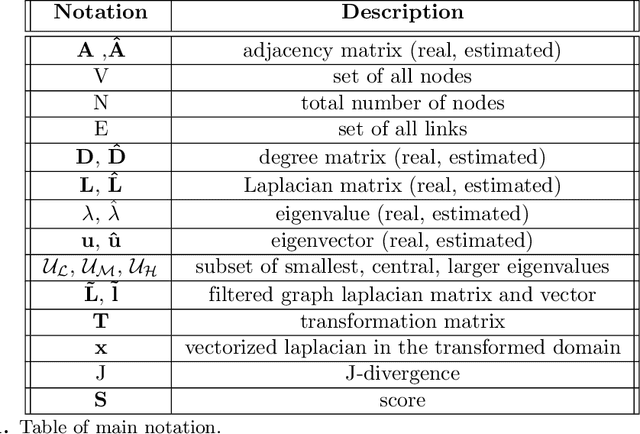
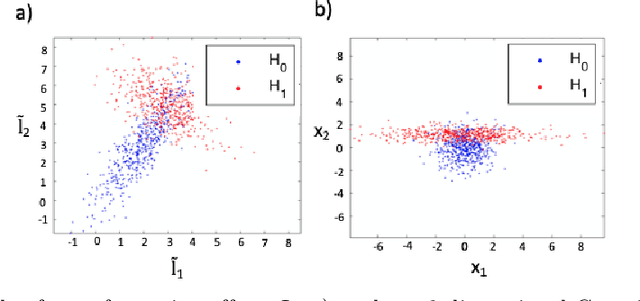
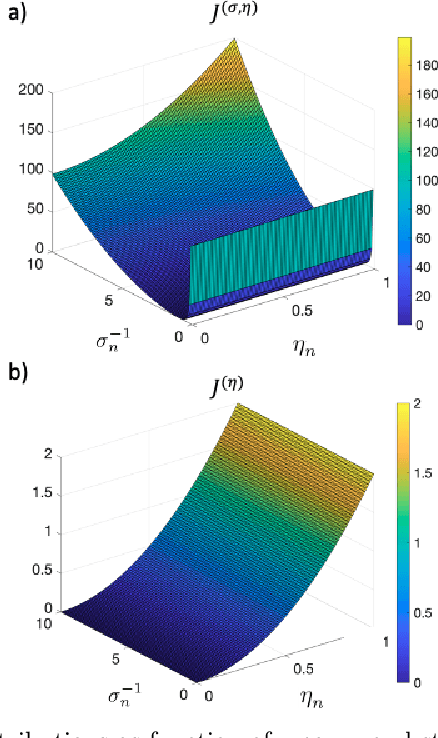
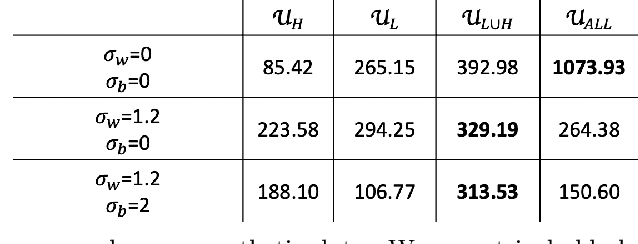
Abstract:Functional connectivity (FC) can be represented as a network, and is frequently used to better understand the neural underpinnings of complex tasks such as motor imagery (MI) detection in brain-computer interfaces (BCIs). However, errors in the estimation of connectivity can affect the detection performances. In this work, we address the problem of denoising common connectivity estimates to improve the detectability of different connectivity states. Specifically, we propose a denoising algorithm that acts on the network graph Laplacian, which leverages recent graph signal processing results. Further, we derive a novel formulation of the Jensen divergence for the denoised Laplacian under different states. Numerical simulations on synthetic data show that the denoising method improves the Jensen divergence of connectivity patterns corresponding to different task conditions. Furthermore, we apply the Laplacian denoising technique to brain networks estimated from real EEG data recorded during MI-BCI experiments. Using our novel formulation of the J-divergence, we are able to quantify the distance between the FC networks in the motor imagery and resting states, as well as to understand the contribution of each Laplacian variable to the total J-divergence between two states. Experimental results on real MI-BCI EEG data demonstrate that the Laplacian denoising improves the separation of motor imagery and resting mental states, and shortens the time interval required for connectivity estimation. We conclude that the approach shows promise for the robust detection of connectivity states while being appealing for implementation in real-time BCI applications.
Human brain distinctiveness based on EEG spectral coherence connectivity
Mar 23, 2014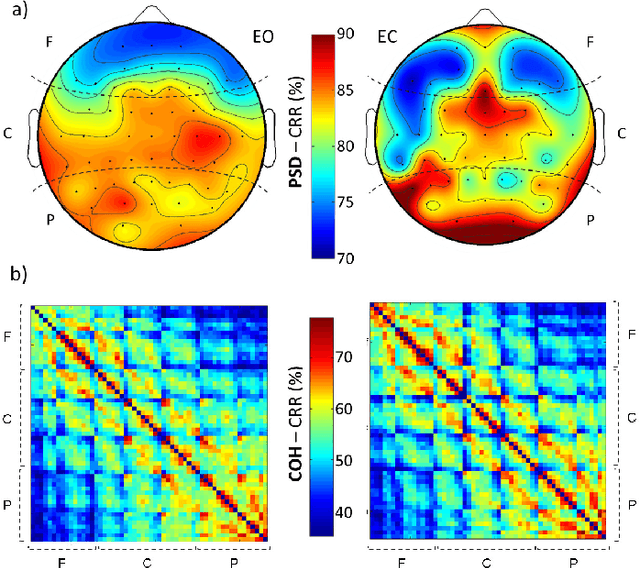

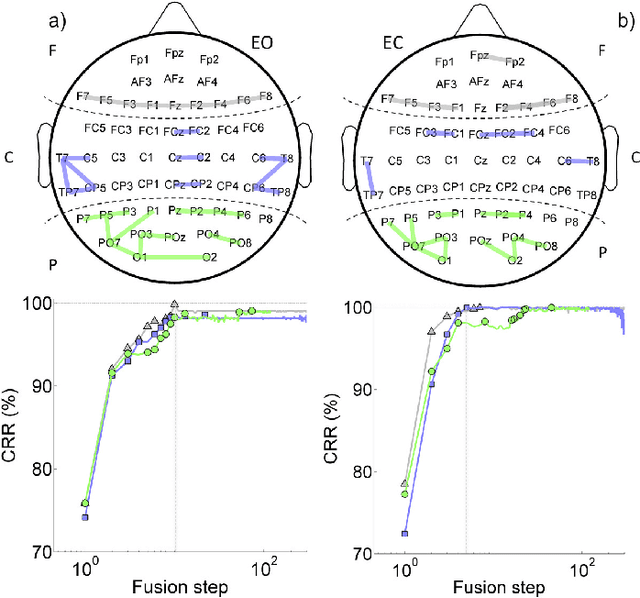

Abstract:The use of EEG biometrics, for the purpose of automatic people recognition, has received increasing attention in the recent years. Most of current analysis rely on the extraction of features characterizing the activity of single brain regions, like power-spectrum estimates, thus neglecting possible temporal dependencies between the generated EEG signals. However, important physiological information can be extracted from the way different brain regions are functionally coupled. In this study, we propose a novel approach that fuses spectral coherencebased connectivity between different brain regions as a possibly viable biometric feature. The proposed approach is tested on a large dataset of subjects (N=108) during eyes-closed (EC) and eyes-open (EO) resting state conditions. The obtained recognition performances show that using brain connectivity leads to higher distinctiveness with respect to power-spectrum measurements, in both the experimental conditions. Notably, a 100% recognition accuracy is obtained in EC and EO when integrating functional connectivity between regions in the frontal lobe, while a lower 97.41% is obtained in EC (96.26% in EO) when fusing power spectrum information from centro-parietal regions. Taken together, these results suggest that functional connectivity patterns represent effective features for improving EEG-based biometric systems.
 Add to Chrome
Add to Chrome Add to Firefox
Add to Firefox Add to Edge
Add to Edge